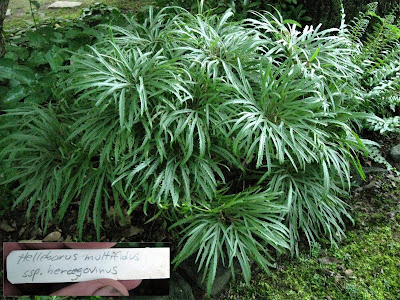
I planted 27 accessions of Stefan's collections today and I have half a dozen to go. I figure, what the heck! We sent him over there, he made the collections, he's grown them out and now we might as well see what they'll do in the garden. I like the problem solving aspect of taking a truckload of plants with various requirements for soil, moisture, light, space,...out into an existing garden and inserting them in such a way as to show off their characters and enhance the beauty of the collection. I didn't say I was that good at it, just that I enjoyed doing it. As it turns out, I am pretty happy with most of the placements, very happy with some, and at least satisfied with the rest. It was my though that, in addition to those other parameters, it would be nice if I could concentrate them in a few areas to make them easier to observe. I succeeded to some extent.
There were a number of plants that demanded perfect drainage so I planted as many of them as I could in the higher up, altitudinaly, of the Rock Gardens that Bradley Evans had installed in China Valley. It sits just above the path below the
Magnolia denudata Memorial Grove. I put a species Helianthus there,
Dianthus ?carthusianum ?,
Sedum pallidum, Arenaria sp., Convolvulus persicus, Erysiumum sp., and a nice small
Eryngium.
Moving down the path and backtracking along the spur trail that leads back to the Central Valley, I planted
Plumbago europaea and a
Salvia verticillata type below the trail among the rocks at the head of the dry stream bed.
Stil farther down the valley on an east facing slope near
Albizzia 'Summer Chocolate', are
Atraphaxis spinosa, Jasminum fruticans, and
a nice prostrate
Anthemis with pinnately compound ferny leaves. Along the stone steps that bisect this large area, I put
Limonium meyeri, ?
Limonium carnosum?, and
Geranium albanum.Walking down the valley along the bottom of this bed, the trail faces south, then makes a sharp bend and continues NE. At this bend, are: bearded type
Iris; a beautiful
Asparagus whose dark foliage has a beautiful and unusual sheen;
Teucrium nuchense; Chamerion stevenii with silvery foliage and pink flowers; and a type of Larkspur with pink flowers. Now I just have to take care of them and watch what happens.


 Their front garden includes a 6-legged octopus created from Juniperus procumbens nana (parts of two arms are visible in the picture), various perennials, assorted dwarf conifers, and a rock garden featuring xerophytes, international and southwestern. The back is a shade garden of textural and tonal contrasts created with hundreds of perfectly grown specimen plants including this unusual hellebore. And.....Joan's new dog Scout made a new friend.
Their front garden includes a 6-legged octopus created from Juniperus procumbens nana (parts of two arms are visible in the picture), various perennials, assorted dwarf conifers, and a rock garden featuring xerophytes, international and southwestern. The back is a shade garden of textural and tonal contrasts created with hundreds of perfectly grown specimen plants including this unusual hellebore. And.....Joan's new dog Scout made a new friend.














